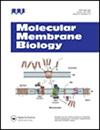Uncoupling protein 2 prevents ischaemia reperfusion injury through the regulation ROS/NF-κB signalling in mice
Q3 Biochemistry, Genetics and Molecular Biology
引用次数: 3
Abstract
Abstract Background and objective: Renal ischaemia reperfusion injury (IRI), characterized by excessive cell apoptosis and inflammation, remains a clinical challenge. Mitochondrial membrane potential is related to apoptosis and inflammation of IRI. Previous studies have indicated that uncoupling protein 2 (UCP2) and its receptors play an important role in inflammation, apoptosis and injuries, especially in oxidative stress injury. However, the underlying mechanisms of UCP2 in IRI are still not fully understood. Methods and results: In the present study, male C57 mice were randomly divided into three groups:sham, IR, and UCP2-/-+IR. The IRI model was established by removing the right kidney and clamping the left kidney for 45 min followed by reperfusion. Blood urea nitrogen (BUN) and creatinine were higher in UCP2-/-+IR mouse serum than in IR mouse serum. In addition, relative to the IR group, UCP2-/-+IR mouse renal cells had increased reactive oxygen species (ROS) production, aggravating tissue damage. We examined changes in the NFκB pathway and found that after UCP2 knockdown, IκB and IKK phosphorylation increased, and nuclear NFκB increased, which stimulated inflammation. Moreover, there was an increase in apoptosis in the UCP2-/-+IR group. Conclusion: UCP2 can prevent IRI in C57 mice. Mechanistically, UCP2 may decrease ROS expression, NFκB activation and caspase-3 cleavage, rendering UCP2 a potential therapeutic target against IRI.解偶联蛋白2通过调节小鼠ROS/NF-κB信号传导预防缺血再灌注损伤
摘要背景和目的:肾缺血再灌注损伤(IRI)以细胞过度凋亡和炎症为特征,仍然是一个临床挑战。线粒体膜电位与IRI的细胞凋亡和炎症反应有关。先前的研究表明,解偶联蛋白2(UCP2)及其受体在炎症、细胞凋亡和损伤中发挥着重要作用,尤其是在氧化应激损伤中。然而,UCP2在IRI中的潜在机制仍不完全清楚。方法和结果:本研究将雄性C57小鼠随机分为假手术组、IR组和UCP2-/-+IR组。通过切除右肾并夹紧左肾45分钟,然后再灌注来建立IRI模型。UCP2-/-+IR小鼠血清中的尿素氮(BUN)和肌酐高于IR小鼠血清。此外,与IR组相比,UCP2-/-+IR小鼠肾细胞的活性氧(ROS)产生增加,加重了组织损伤。我们检测了NFκB通路的变化,发现UCP2敲低后,IκB和IKK磷酸化增加,核NFκB增加,从而刺激炎症。此外,UCP2-/-+IR组的细胞凋亡增加。结论:UCP2可预防C57小鼠IRI。从机制上讲,UCP2可能降低ROS的表达、NFκB的激活和胱天蛋白酶-3的切割,使UCP2成为对抗IRI的潜在治疗靶点。
本文章由计算机程序翻译,如有差异,请以英文原文为准。
求助全文
约1分钟内获得全文
求助全文
来源期刊

Molecular Membrane Biology
生物-生化与分子生物学
CiteScore
4.80
自引率
0.00%
发文量
0
审稿时长
>12 weeks
期刊介绍:
Cessation.
Molecular Membrane Biology provides a forum for high quality research that serves to advance knowledge in molecular aspects of biological membrane structure and function. The journal welcomes submissions of original research papers and reviews in the following areas:
• Membrane receptors and signalling
• Membrane transporters, pores and channels
• Synthesis and structure of membrane proteins
• Membrane translocation and targeting
• Lipid organisation and asymmetry
• Model membranes
• Membrane trafficking
• Cytoskeletal and extracellular membrane interactions
• Cell adhesion and intercellular interactions
• Molecular dynamics and molecular modelling of membranes.
• Antimicrobial peptides.
 求助内容:
求助内容: 应助结果提醒方式:
应助结果提醒方式:


